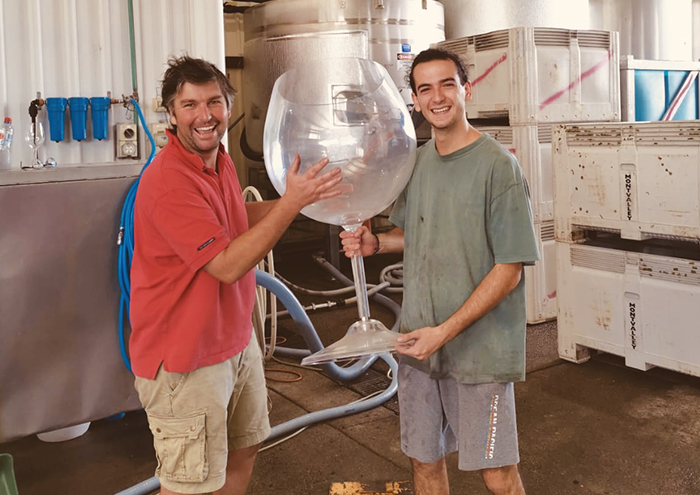While in Italy the vineyards are cradled by the snow, in Australia and in New Zealand the wineries are in ferment and are harvested tirelessly. Thanks to our Mario, who at the age of just 19 is on the other side of the world grappling with his first winery experience in Australia, we can experience the beauty of this season twice in 2019.
Now let’s leave the word to him and his story! Enjoy the reading!
“Are you enjoying the cool of home? In these parts the temperatures are really hot! This year the grape yield in the vineyard is less than last year, but the quality is not lacking.
February is coming to an end and the more time passes, the more my beginner mind is flooded with new information, notions and many curiosities. I’m having the luck to touch the reality of winemaking in the lively Hunter Valley, thanks to the work of cellar hand at Binet Family Wines.

The owner of this family business, Daniel Binet, is an excellent winemaker as well as a patient teacher. He has French origins, a great experience in Australia and New Zealand and has married a girl with Italian origins. A true mix of cultures that are found in its wines while respecting the Australian identity.
Now, without further ado, I will tell you about this fascinating enological reality and my daily activities.
The harvest in Australia.
As everybody knows, white grapes have precedence in the cellar. The protagonists here are undoubtedly the Semillon – this area is iconic for this variety – Chardonnay and Verdello. With a little patience the red grapes also arrive, in particular the Shiraz and the Cabernet Sauvignon. Some wineries then indulge in processing Italian varieties such as Fiano, Vermentino, Trebbiano, Moscato and even our beloved and Piedmontese Arneis.
Barbera, Nebbiolo and Dolcetto could not miss as well. Eventually I also worked with some French varieties like the Viogner, Souvignon Blanc, Merlot, Pinot Gris and Noir. As I told you in the previous article the vineyards were imported from Europe only in the 18th century, so no varieties have yet developed here in Australia.

After a peek in the vineyards we pass to the process of harvesting the grapes and their arrival in the cellar. The harvest is for the most part mechanized with the latest generation of grape harvesters. From here the grapes are then poured into containers of about 1 ton, which are loaded onto the trailer and shipped to the cellar. All this is done during the night to avoid the hottest hours of the day that otherwise would cause stress to the berry .
Transformation of grapes into the beloved drink of God Bacchus.
Once arrived at destination, the grapes are examined determining the sugar content and acidity, the level of stress and of course its quality. After the first observations and the necessary calculations we proceed with the addition of: tartaric acid to control the pH, enzymes to increase the yield of the pressing and, if you notice that the grapes are not clean and clear, sulphites that disinfect and prevent oxidation.
At this point we pass to the destemmer-crusher where the grape will be separated from the stalk and sent to the cooling line. If it is white wine, it will be pressed and put in the tank, if red it will go directly to the fermentation tank. With the raw white musts a second correction of the ph is carried out and clarifying products are added. In a couple of days when the must has stabilized, the tank changes to allow the separation from the deposits.
Now the red and also our white can face fermentation with the addition of active yeasts, called sacaromincensis cerviisiae and nutrients to facilitate their development. This process will offer its best performance in a temperature between 14 and 18 degrees for whites, and 22 and 26 degrees for reds. Usually the fermentation takes place in 1 or 2 weeks, paying close attention to the end of the process, as well as the most delicate moment. The main reason is that the wine, if stressed, can acquire unwanted odors and flavors, very difficult to control after the process.
Concluding with other sulphites and bentonite to stabilize the product, white wine is ready to rest in a third tank. Instead, the red is exposed to a malolactic bacterium for a second fermentation, then pressed and subsequently clarified.

We thus arrived at the end of the procedure. At this point our grapes, now transformed into wine, finish the period of aging in the tank. The next step will be the bottling to get them ready for sale. The key factor learned during this experience and that distinguishes the winemaking techniques from each other is time, or rather the different timing applied to each process underwent by the product.
Well, if you have arrived here I thank you! ????
I’m really excited about this first job adventure. Soon I will move to start the second, so keep following me! I will take you for Australia (or maybe for New Zealand!).
Until next time! ”



magnificent put up, very informative. I wonder why the opposite
specialists of this sector do not notice this.
You should proceed your writing. I’m confident, you
have a great readers’ base already!
yo yo yo my boy mario- Harley Jameson Lamar, Colorado